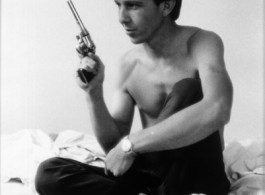Press Release
Simon Lee Gallery Hong Kong is proud to present the work of internationally acclaimed photographer and filmmaker Larry Clark for the first time in Asia.
Larry Clark holds a seminal position in American photography. Widely known for his treatment of teenage sexuality, violence and drug use, Clark’s contentious photographs and films are simultaneously unimaginable and unforgettable. Simon Lee Gallery Hong Kong is pleased to present selections from both Tulsa (1963 – 1971) published in 1972 and Teenage Lust (1963 – 1983) first published in 1983 and expanded in 1987.
The trajectory of Clark’s career and often-controversial representations of American youth culture have their roots in Clark’s marginalized origins and his own early outlaw existence. Clark’s mother was a travelling baby photographer whom he assisted as a salesman and photographer. Used to having his camera by his side, Clark discovered that his friends were willing subjects for what were to become pivotal explorations into the underbelly of the American dream. Clark’s candid engagement with his milieu has seen him pursue important social issues pertaining to the construction of masculinity in American culture, the exploitation of teenagers by the mass media and the destructiveness of dysfunctional family relationships.
Tulsa, which was gathered on several forays in Clark’s home-town in Oklahoma, is now considered a classic memento mori of the period. Clark’s ability to encapsulate the social and cultural shifts in American society is one of the overriding strengths of Tulsa and marked him as a significant figure in the canon of late twentieth century photography. The subjects of Tulsa were Clark’s drug buddies and his unselfconscious handling of the drugs scene and its repercussions, make for unsparing statements on Vietnam-era America. Clark’s own teenage years correlated with an increasing rejection of the middle-class ethos in the 1940s and 1950s. Culturally this rejection was reflected by the Beat literature of writers like Jack Kerouac and William S. Burroughs and also influenced movies including, Rebel without a Cause (1955), Blackboard Jungle (1955) and I was a Teenage Werewolf (1957). The alienation from mainstream society that Clark’s early imagery evokes is perpetuated in his second series of photographs, Teenage Lust. This series chronicled the next generation of Tulsa teenagers as well as male hustlers in New York City. It consists of
out-takes from Tulsa and new material, which is loosely autobiographic. Teenage Lust has an awkwardness reflecting Clark’s desire to make sense of his life and brings him full circle recalling the activities in Tulsa he was attempting to escape. His desire to implicate himself in the narrative of Teenage Lust saw him using additional devices such as confessional text, news clippings and family photographs. Ultimately this series established Clark’s enduring impulse towards the margins and his desire to offer an insight into subcultures largely unseen by a wider public.
Larry Clark’s remarkable influence on the style and subject matter of subsequent generations of photographers and filmmakers has been extensively acknowledged. His mythologizing of the criminal margins reflects an age-old fascination within American culture. This defining myth and Clark’s particular preoccupation with mass media’s exploitation of adolescents, has influenced the work of photographers such as Richard Prince and Nan Goldin. His recognized impact on Hollywood is present in the films such as Taxi Driver (1976) by Martin Scorsese, Rumble Fish (1983) by Francis Ford Coppola and Drug Store Cowboy (1989) by Gus Van Sant.
In 1995 Larry Clark released his first feature film at the Cannes Film Festival, Kids which was lauded as an instant classic. Other film projects include Another Day in Paradise (1998), Bully (2001), Ken Park (2002), Wassup Rockers (2005) and his most recent feature Marfa Girl which premiered November 2012 at the 7th Rome Film Festival won the Golden Marcus Aurelius Prize. Larry Clark’s work is represented in the photography collections of many major museum collections, including the Metropolitan Museum of Art, New York, The Museum of Modern Art, New York, The San Francisco Museum of Modern Art and Pinakothek Der Moderne, Munich.



